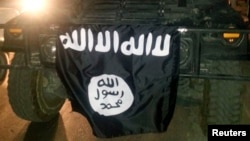When Islamic State propaganda material and flyers turned up in parts of South Asia last month, they were accompanied with news headlines like these: “ISIS Makes Inroads in Afghanistan, Pakistan,” from Foreign Policy magazine, and, “Ultra-Radical Islamists Move to Take Over From 'Tired'Taliban, al-Qaida Leaders,” from Canada's CBC News website.
Many people speculated that the extremist group that has grabbed the world’s attention in Iraq and Syria is now trying to get a foothold in the al-Qaida stronghold in South Asia. Not so, say some terrorism experts who watch South Asia.
“What I suspect is not that ISIS is trying to expand but a lot of jihadist groups in this area are drawn to them,” says Praveen Swami, national editor for strategic and international affairs for The Indian Express.
Jamat ul Ahrar, a group that broke away from Tehreek-e-Taliban Pakistan or TTP, has already announced its support for Islamic State. ISIS stickers were spotted on cars in the Pakistani city, Peshawar, and IS graffiti, flags and banners appeared in Indian-administered Kashmir, according to some news sources.
Meanwhile, a 12-page booklet called Fatah or Victory in the Pashto and Dari languages was reportedly distributed in Afghan refugee camps near Peshawar.
Kamran Bokhari, Middle East and South Asia adviser to intelligence firm Stratfor, says he thinks that the presence of flyers or banners alone is not enough to prove Islamic State has decided to expand to South Asia. The group is using all its resources to fight in Iraq and Syria, he says, and if it gets South Asian recruits, it will try to lure them to that war front rather than branching out at this time.
“The flyers may be coming from local jihadists or even ultra conservative youth,” says Bokhari.
A local prayer leader told the Reuters news agency that the flyers were being distributed by a “little-known local group called Islami Khilafat, an outspoken ISIS supporter.”
Swami says he agrees that ISIS might have picked up a fan following in South Asian jihadi circles.
“In the 1980's, Mullah Omar was a rock star for jihadists because he set up a state. In the 1990's, Bin Laden was a rock star. These people have become hero figures for local jihadists,” says Swami.
Arif Jamal, an author of multiple books on Pakistani militants, says he senses a rudimentary organization of ISIS that may develop into a full-fledged presence.
“There are many groups that think like ISIS," he said. "And at this time in Pakistan, everything is chaotic and groups are coalescing.”
Any one of those groups can become an ISIS franchise at any time. Many Pakistani, Indian, and Bangladeshi jihadists are already fighting with ISIS in Iraq and Syria. It is not clear how many have come home from Syria and whether any of them have been a significant ISIS leader. Jamal says he thinks that some of them may have contacted their groups back home and encouraged an affiliation with ISIS.
Just weeks after the pamphlets appeared, militants carrying the black flag of ISIS accompanied the Taliban during a deadly attack on Afghanistan’s Ghazni province. Sixty or more people were killed, at least 12 family members of local police officers were beheaded, and dozens of homes were burned.
Meanwhile, al-Qaida has announced a new branch, Qaidat al-Jihad fi’Shibhi al-Qarrat al-Hindiya, or al-Qaida in the Indian Subcontinent (AQIS). In a video released on Twitter and jihadi websites, al-Qaida’s head, Ayman al Zawahiri, promised Muslims in the region and particularly in India that “your brothers in Qaedat al-Jihad did not forget you and they are doing what they can to rescue you from injustice, oppression, persecution and suffering.”
This is seen mostly as a move to revitalize the al-Qaida branch in South Asia and stop recruits from leaving them for ISIS. The group is still highly influential in the region and has longstanding relationships with local militant groups like the Pakistani and Afghan Taliban.
Its leadership in the region along Pakistan-Afghanistan border, however, has been either holed up or on the run for several years. It might be losing its appeal amongst young, emotionally charged jihadists who want to see action. Al-Qaida has also learned the hard way to remain low key and avoid the Internet and cell phones for fear of being tracked. They may seem ineffective or unimpressive to the new recruits, a lot of whom receive their initial information from jihadi websites or social media forums.
Meanwhile, ISIS is not likely to distance itself from any fan following and copy cat attacks. After all, it may not be their people, but as long as they carry the flag, they help strengthen the image of an expanding global presence and thus a PR victory for the men in black.









